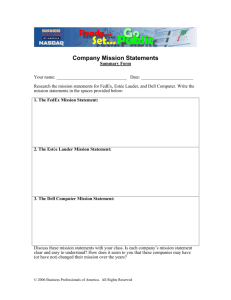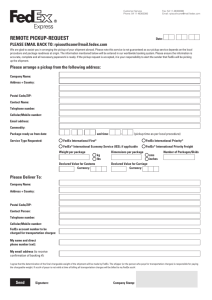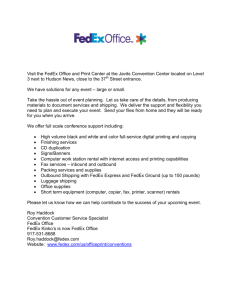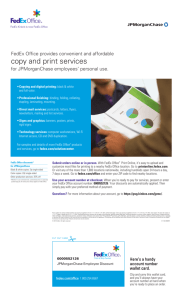BACKGROUND INFORMATION History: FedEx is a logistics
advertisement
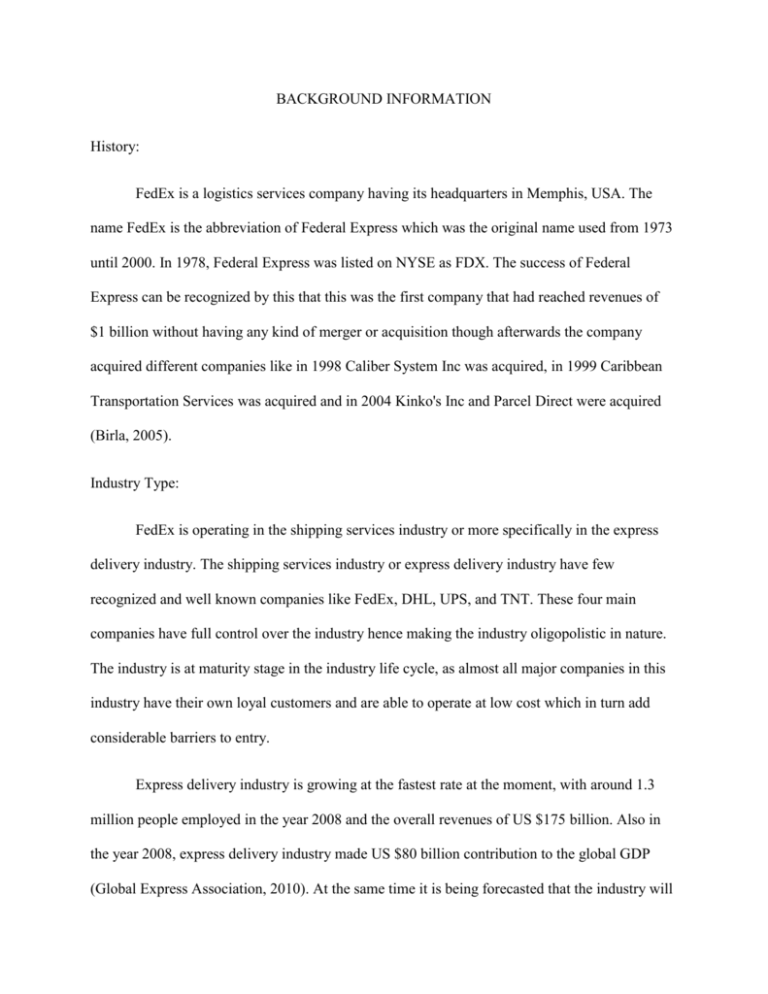
BACKGROUND INFORMATION History: FedEx is a logistics services company having its headquarters in Memphis, USA. The name FedEx is the abbreviation of Federal Express which was the original name used from 1973 until 2000. In 1978, Federal Express was listed on NYSE as FDX. The success of Federal Express can be recognized by this that this was the first company that had reached revenues of $1 billion without having any kind of merger or acquisition though afterwards the company acquired different companies like in 1998 Caliber System Inc was acquired, in 1999 Caribbean Transportation Services was acquired and in 2004 Kinko's Inc and Parcel Direct were acquired (Birla, 2005). Industry Type: FedEx is operating in the shipping services industry or more specifically in the express delivery industry. The shipping services industry or express delivery industry have few recognized and well known companies like FedEx, DHL, UPS, and TNT. These four main companies have full control over the industry hence making the industry oligopolistic in nature. The industry is at maturity stage in the industry life cycle, as almost all major companies in this industry have their own loyal customers and are able to operate at low cost which in turn add considerable barriers to entry. Express delivery industry is growing at the fastest rate at the moment, with around 1.3 million people employed in the year 2008 and the overall revenues of US $175 billion. Also in the year 2008, express delivery industry made US $80 billion contribution to the global GDP (Global Express Association, 2010). At the same time it is being forecasted that the industry will continue showing the growing trend because of the growing demand of mode of transport which is efficient and consume less time. Around 8 percent growth is being forecasted in the industry and it is being estimated that express delivery industry will be a source of around 4.5 billion direct employment all over the world by the year 2013 (Oxford Economic Forecast, 2005). The main driving factor behind the growth of the shipping services industry is the on time and efficient delivery of items. The overall shipping service industry is dynamic in nature because of different variety of needs of customers. People belonging to different sectors of life require service of shipping packages or important documents to different locations, but the nature of service required by different individuals will vary. Apart from individual consumers the various companies belonging to different segments and high tech industry like electronics, information technology, financial service, pharmaceuticals, automotives, textiles etc are also valuable customers of the companies operating in the shipping service industry or express delivery industry (Oxford Economic Forecast, 2005). The major technological advancement which has changed the overall shipping service industry is the internet and information technology. On one hand internet and information technology has posed serious threats to the industry by the introduction of electronic document delivery specifically e-mail. On the other hand it had allowed the companies to provide customers with additional benefits and convenience with the help of internet and information technology. With the implementation of different technologies now customers are not required to go to the nearest franchise or delivery center for dropping the packages, they can order the pick up through internet or making a call. At the same time the customers can track the location of their package with the help of shipment status. Porter’s Five Forces Analysis: Risk of new entry by competitors: There are high barriers to entry because of the high fixed cost required to establish a transportation network on international level. Apart from this the companies which are already operating in the industry have the advantage of low operating cost because of the economies of scale. Extent of rivalry between existing companies: The shipping service industry is highly competitive in nature and there is an ongoing battle among the companies for market share like FedEx and UPS. The switching cost in the industry is considerably low for the customers which in turn also contribute in increasing the level of competition. Apart from this the high exit barriers because of the cost of the transportation infrastructure also results in increasing the rivalry among the companies operating in the industry. Bargaining power of buyers: The bargaining power of buyers or customers is high in the shipping service industry because of the low cost of shifting from one company to another. The customers can shift to the company which will provide on time delivery at low cost. Apart from this the big companies and corporations have high bargaining power for quantity discounts as they ship large volumes. Bargaining power of suppliers: The bargaining power of suppliers is considerable low and the shipping companies have influence on the suppliers prices. The shipping service providers buy in large volumes and have direct impact on the prices quoted by the suppliers. Threat of substitute products: There are very less substitute products to the shipping services. The growing international businesses require services to ship their products and documents from one place to another and there are no other fast and reliable mode of shipping the goods. Risk of New Entry Low to Moderate Supplier Power Existing Competition Buyers’ Power Low High High Substitute Products Low Position With-in Industry: FedEx is operating in highly competitive and saturated industry. The company has the advantage of being the leader in bringing in different concepts and technologies to the shipping service industry (Song, 2003). FedEx introduced the concept of overnight shipping and ultimately the whole shipping industry had to change in order to fulfill the expectations created by FedEx. Similarly, in 1994, FedEx introduced the concept of online tracking with the launch of tracking application website and provided each individual customer with unique bar code (Birla, 2005). FedEx Express is the largest express transportation company in the world, whereas FedEx Ground is the second largest ground delivery service provider within the North America. The leader in the ground delivery sector is UPS. The market share of FedEx is 31 percent whereas that of UPS is 25 percent. US Postal Service with 32 percent market share is striving hard to maintain the largest share in the industry (Shult, 2008). Evolution of Growth: FedEx has been following the strategy of constant evolution and continuous improvement in order to gain considerable market share in the industry. The company has been the leader in bringing in different new ideas in the shipping industry. Apart from the introduction of the overnight shipping and online tracking there are several other important changes which have been initiated by FedEx. Since its inception in the year 1973, the company has continuously evolved and changed (Lester, 2008). Issues with Case: The major issue highlighted in the case which is being faced not only by FedEx but also by all other companies in the industry is the rapid technological advancements. The ongoing changes in the technological environment are posing serious threat to the operations of the shipping service providers. The mature market of overnight delivery along with tremendous technological changes resulted in creating serious challenges for FedEx. In order to cope up with these challenges FedEx followed the strategy of continuous innovation and growth. FedEx came up with different new services and benefits for the customers and created a competitive advantage of other competitors. MANAGEMENT: Organizational Structure: Diane Miller Stokely FedEx Customer Information Services Inc. COO David Bronczek President and CEO, FedEx Express T. Michael Glenn VP Operations, President/ CEO FedEx Service Douglas Duncan President and CEO, FedEx Frieght Frederick Smith David F. Rebholz Chairman, President, and CEO President and CEO, FedEx Ground G. Elmond Clark President and CEO, FedEx Trade networks Christine Richards EVP, General Consumer, Secretary Robert Carter EVP and CIO Alan Graf EVP and CFO Management Style: With different services and business units FedEx has implemented the multidivisional organizational structure. Corporate top management is responsible for the providence of the strategic direction and overall financial reporting. Each individual division or business unit has been provided with authority to manage its operations and services. FedEx follow the participative management style in order to manage its integrated portfolio (Lester, 2008). Mission: The mission statement of FedEx as mentioned on the corporate website is (FedEx): “FedEx Corporation will produce superior financial returns for its shareowners by providing high value-added logistics, transportation and related business services through focused operating companies. Customer requirements will be met in the highest quality manner appropriate to each market segment served. FedEx will strive to develop mutually rewarding relationships with its employees, partners and suppliers. Safety will be the first consideration in all operations. Corporate activities will be conducted to the highest ethical and professional standards.” Vision: The vision of FedEx is to become leader in the international shipping industry. All operations and competencies of the company are directed towards the attainment of this corporate vision. Culture: FedEx focus on maintaining an organizational culture which focus on innovation through employee participation and empowerment. The company give high value to the people or employees of the company and at the same time ensure integrity in all business processes and operations. The main focus of any strategy of the company is the end level customers and their satisfaction (FedEx). Core Competency: The core competencies of FedEx includes high brand equity, strong and established infrastructure, and the commitment and dedication of the company towards innovation and technological advancements (FedEx). FINANCIAL: Revenue Growth: (FedEx, 2010) In past, the company was enjoying growth and improving its revenues but since 2008, revenue of the company has been declining. Revenue recorded in 2008 was $38 billion and since then it has decreased to $34.7 in 2010 showing a decline of 8.68% in two years whereas in comparison to this, the company had increased its revenue by 17.65% in two years from 2006 to 2008 (FedEx, 2010). Operational Expense: (FedEx, 2010) (FedEx, 2010) (FedEx, 2010) Operating profit margin of the company has also declined in last five years. Profit margins recorded in 2006 and 2007 were 9.3% and since then it has declined to 2.1% and 5.8% in 2009 and 2010 respectively (FedEx, 2010). Profit Margin: Years 2010 2009 2008 2007 2006 Net Profits In Millions 1184 98 1125 2016 1806 Revenues In Billions 34.7 35.5 38 35.2 32.3 Profit Margin Percentage 3.41% 0.28% 2.96% 5.73% 5.59% Net profit of the company has been fluctuating since 2006 from where it was $1,806 and increased to $2,016 in 2007 and then after more fluctuations eventually in 2010 net profit of the company was recorded to be $1,184. Similarly, profit margin of the company has been fluctuating, from 5.59% in 2006 it increased slightly to 5.73% and then it declined to 2.96% in 2008, 0.28% in 2009 from where it increased to 3.41% in 2010 (FedEx, 2010). Capitalization: (FedEx, 2010) Capitalization ratio was around 17.5% in 2006 and 2007 but then capital structure of FedEx changed and debt ratio was 12.1% and then it increased to 15.9% in 2009. Now, FedEx has further reduced the debt to capitalization ratio and in 2010 it is 12.3% (FedEx, 2010). Stock Performance: (FedEx, 2010) (FedEx, 2010) Stock of FedEx has been one of the most demanded during 2005 to 2007 as after this time the stock price of the company started falling. Stock performance is directly related to the performance of FedEx and as the profitability of the company declines, stock price reflects this scenario (FedEx, 2010). When comparing the stock performance of FedEx with other players in the industry then FedEx has not been able to outclass its competitors however, the stock performance of transportation industry is showing a similar trend as it also increased initially and then declined. Short and Long Term Debt: (FedEx, 2010) Current liabilities of the company decreased by 13.58% whereas long term liabilities increased from 2009 to 2010 by 14.75% Cash Position: Cash in hand of the company declined in 2010 to $2 billion from $2.3 billion in 2009 showing a 15% decline (FedEx, 2010). MARKETING: Product Lines: FedEx has divided itself into seven different divisions or business units namely (Lester, 2008): 1. FedEx Express 2. FedEx Ground 3. FedEx Office 4. FedEx Freight 5. FedEx Custom Critical 6. FedEx Trade Networks 7. FedEx Supply Chain Core Product: The core product of FedEx is the overnight delivery service provided to different customers (Lester, 2008). Distribution Model: FedEx initiated the new approach in distribution, which is Hub and Spoke model, in order to support the integrated express delivery system and the global coverage of the company. The Hub and Spoke model allowed the company to form a large Hub in a certain region which was responsible for delivery and pick up to and from the centers in the cities and locations near to that hub (Lester, 2008). Pickup 2 Delivery 1 City City HUB Pickup 3 City City 1 Pickup 1 Delivery 2 Delivery 3 1 Competitors: FedEx has been facing intense competition from the UPS, U.S. Postal Service, DHL, TNT, Emery, RPS, and electronic document delivery (Lester, 2008). Geographic Representation: FedEx is operating in several international countries. The company has established regional hubs and centers in different countries of South and North America, Europe, and Asia (Lester, 2008). Promotional Medium and Method: FedEx has been able to achieve success and growth because of the effective marketing strategy. The company knows the art of identifying and fulfilling the untapped needs of the customers. Apart from this FedEx develop different marketing strategies for different regions. The marketing channel and communication medium is also selected according to the preferences of the local market (Lester, 2008). Positioning Strategy: FedEx has positioned itself as the leader in the industry of shipping services not only in term of providing quick and efficient services but also providing new technology solutions to the customers (Lester, 2008). SWOT ANALYSIS: Areas of Strength: One of the main strengths of FedEx is that they always have been coming up with different innovative and original ways to satisfy customers. FedEx has always been willing to take on new technological advancements to improve their quality of services like they employed wireless technology to improve tracking of packages in addition to adding an option on their website from where customers can directly track the progress of their delivery. FedEx always considers the needs of customers. They are able to deliver to more than two hundred countries because of their own large fleet of aircrafts (Marshburn, 2007). Brand image of FedEx is one of its strengths. Areas of Weaknesses: FedEx has not been successfully able to differentiate itself from its competitor particularly UPS because of which they are not able to gain competitive advantage, despite of them an important member in the industry (Marshburn, 2007). Because FedEx has always been spending to improve their infrastructure this is increased the overall cost of FedEx and because of this reason they are able to offer low prices to their customers. Thus, UPS has competitive edge over FedEx when it comes to pricing (Marshburn, 2007). Areas of Opportunities: Globalization has offered several opportunities for express delivery companies to expand and improve their profitability. With advancement of technology and particularly ecommerce, an increasing need for express delivery has been created (Marshburn, 2007). Because starting a business in this industry is very costly, there will be hardly new entrants in the industry coming up (Marshburn, 2007). Areas of Threats: Because such businesses have high fixed cost, therefore when the sales are low profitability of the company can be decreased drastically. It is very difficult for any company to become the market leader because of the nature of the industry (Marshburn, 2007). Emails have become a major threat for such companies. Competitors like DHL and UPS are always a threat for FedEx (Marshburn, 2007). MAJOR CHALLENGES FACE BY ORGANIZATION: FedEx is facing immense challenges in view of the saturated and highly competitive industry. The company is facing the issue of high fuel cost and thus it is becoming difficult to maintain low operational cost. This in turn puts high competitive pressure on the company as low operational cost is the major source of competitive advantage in the industry. Apart from this the company is also facing challenging because of ongoing technological changes and advancements. RECOMMENDATION: In the Area of Management: FedEx needs to adopt a culture that encourages innovation, creativity and originality in order to come up with services that are different from other competing firms which will be helpful in gaining competitive advantage. In the Area of Financial: FedEx needs to come up with different innovative ideas and solutions to cater the needs of the customers in order to improve their profitability. Companies in express delivery industry need to reduce their operational costs, and if FedEx is able to reduce its operational cost then it could offer delivery at lower prices thus gaining competitive advantage over its competitors. Currently, salaries and benefits to employees contribute more than 40% of total sales, and this is one area where FedEx can save costs though it needs to ensure that the motivation level of employees does not decrease. In the Area of Marketing: FedEx needs to find different niche that have been either neglected or not been identified by the competitors. This will allow FedEx to not only maintain its current position in the industry but improve its market share as well. Challenges: FedEx has to continue with the policy of innovation and have to come up with new technological services for the customers in order to overcome the challenges and attain the position of market leader. REFERENCES Birla, M. (2005). FedEx Delivers: How the World’s Leading Shipping Company keeps Innovating. NJ: John Wiley & Sons Inc. FedEx. (2010). Annual Report 2010. Retrieved August 7, 2011, from <http://files.shareholder.com/downloads/FDX/1349824504x0x395636/5b8f7453-b9604f0f-92cd-ec27cab06760/FedEx_2010_AR.pdf> FedEx. Mission, Strategies, Values. Retrieved August 7, 2011, from <http://about.fedex.designcdt.com/our_company/company_information/mission_stateme nt> Global Express Association. (2010). Discussion Paper of Express Delivery Services. UK: Global Express Association. Retrieved August 7, 2011, from <http://www.globalexpress.org/assets/files/GEA%20discussion%20paper%20on%20Express%20Delivery% 20Services,%20Feb.%202010.pdf> Lester, D. (2008). Making the Case for Sustainable Strategic Management: an assessment of FedEx. International Journal of Sustainable Strategic Management, 1(1), 82-97. Marshburn, K. (2007). Strategic Analysis of the FedEx Corporation. USA: Washington College. Oxford Economic Forecast. (2005). The Impact of the Express Delivery Sector on the Global Economy. UK: Oxford Economic Forecasting. Shult, K. (2008). Battle of Brands: UPS vs. FedEx. Retrieved August 7, 2011, from <http://www.bloggingstocks.com/2008/05/05/battle-of-the-brands-ups-vs-fedex/> Song, H. (2003). E-Service at FedEx. Communications of the ACM, 46(6).



